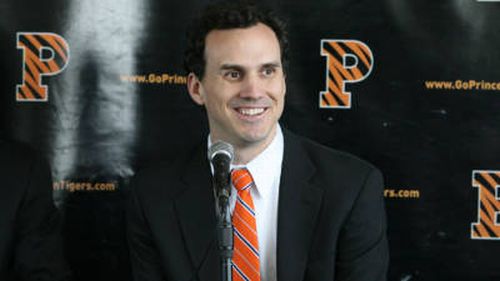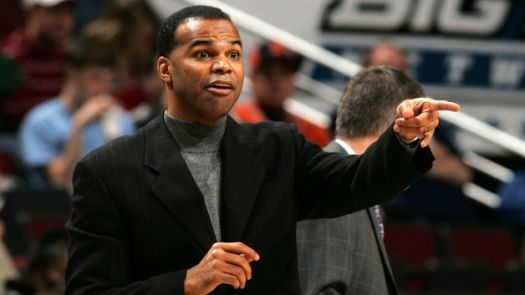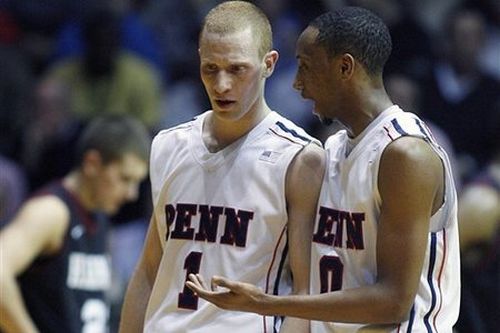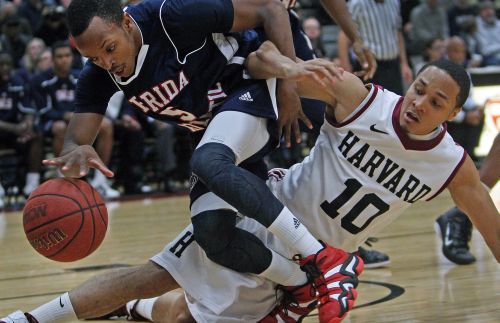Ivy League Season Wrap-Up & Postseason Preview
Posted by Brian Goodman on March 8th, 2012Michael James is the RTC correspondent for the Ivy League. You can also find his musings on Twitter at@mrjames2006 and @ivybball.
Reader’s Take
A Look Back
In by far the toughest Ivy since the 1970s, Harvard delivered exactly as expected, slogging through the treacherous league slate with a 12-2 mark and a second Ivy title. What wasn’t expected was the company the Crimson would have at the top. The average expectation had no other Ivy teams eclipsing the 10-win plateau, but Penn paid no heed to those projections. After losing to Harvard 56-50 at home to fall two games off the pace, the Quakers ripped off an amazing stretch of seven straight wins to climb even in the loss column after the final Ivy back-to-back weekend. But tradition left Penn with work to do. Its second-most difficult game of the season still remained – the annual meeting with rival Princeton after the rest of the league’s regular seasons had already drawn to a close. The Tigers double-teamed Quaker star Zack Rosen all game, stifling the Penn offense, and executed efficiently on the other end, cruising to a 10-point victory and ending the Quakers’ title hopes.
It was a historic year for the league by a variety of metrics. The league has never posted a higher Pomeroy Rating in the efficiency era, has never had seven non-conference wins over Pomeroy Top 100 teams in a season, and has never had a higher ranked team in the Pomeroy era than Harvard at No. 37. It is also currently hanging on to the 13th spot in the Conference RPI rankings, which would eclipse the 2001-02 mark of 14th, and could have as many as four teams earn postseason bids. With so many pivotal seniors, it will be hard for the Ivies to avoid a collective step back, but with a solid incoming freshman class, don’t expect a return to the dark ages of 2008 and 2009.
Yale and Princeton each posted solid campaigns, flirting with the RPI Top 100 for most of the season and building postseason-worthy resumes – the former by its quantity of wins and the latter with its quality. Columbia had a great non-conference run followed by an incredibly unlucky Ivy campaign, while Cornell did just the opposite, stumbling a bit outside the league, before putting together a solid 7-7 mark in Ivy play. Brown and Dartmouth had forgettable seasons, but the Bears will return several players from injury and ineligibility while the Big Green will see its talented freshmen continue to grow and mature.
Conference Accolades
Player of the Year: Zack Rosen, G, Penn – It would be comical if the official tally from the league office didn’t wind up being unanimous. Rosen has carried the Quakers on a stunning Ivy League campaign, playing 95 percent of his team’s minutes, while using 29 percent of its possessions and taking 33 percent of its shots. Sure, he’s not a value add defensively and his inability to get to the line during league play left Penn exposed during those rare moments when he went cold from the field.
Those are nitpicks in the grand scheme of things, though. The Ivy League rarely gets the privilege of watching a player with Rosen’s electricity as a shooter, and like a great showman, the senior saved his best performances for the biggest stages, including a stretch over the final five minutes against Harvard that helped Penn erase a nine-point deficit and stun the heavily favored Crimson. Rosen’s performances became even more remarkable as Penn absorbed injury after injury, resulting in a lot of missed playing time for starting swingman Tyler Bernardini and rotation forward Mike Howlett. The Quakers kept right on winning, including a five-game stretch of victories with none of the games being decided until the final minutes. That kept Penn in the race until the final weekend and gave Rosen a spotlight that not only benefited his team but potentially his professional aspirations as well.
Ultimately, he fell one amazing performance short of leading Penn to an Ivy title, but his heroics throughout the league campaign will not be soon forgotten.
Coach of the Year: Mitch Henderson, Princeton – Penn gets all of the publicity for its amazing Ivy run, but the job that Henderson did with the Tigers simply cannot be ignored. The non-conference slate looked choppy at the time, but in retrospect, Princeton’s performance was impressive. It pulled off two Top 100 wins over Florida State and Buffalo, while losing by two at North Carolina State, four at Drexel and six at Bucknell – all Top 100 teams that look even better now than they did at the time. Having to play 12 straight Division I games on the road over the course of two months left the Tigers out of the Ivy race very early on, but Henderson led his team as close to back into the race as possible. He did it through a tremendous understanding of his personnel and how to shape an offense that would exploit their talents most effectively. The result was a 109 Adjusted Offensive Rating in Ivy play and an un-Princeton-like six games eclipsing the 70-point mark.

In A Year Full Of Great Candidates, Princeton's Mitch Henderson Earns Our Nod As Ivy League Coach of the Year
Rookie of the Year: J’Vonte Brooks, F, Dartmouth – The top four Ivy players by free throw rate are all freshmen, but Brooks was the only one of those four seeing more than 50 percent of his team’s minutes. His ability to get to and hit from the line rescued his decently mediocre 44 percent eFG shooting. He was a monster on the boards as well, finishing 11th in offensive rebounding percentage during league play and fifth on the opposite end of the floor.
All-Conference First Team:
- Zack Rosen, G, Penn
- Brian Barbour, G, Columbia – The second-leading scorer in Ivy play was almost impossible to keep out of the paint and off the free-throw line. He also finished the conference slate with the second-highest assist rate behind Harvard’s Brandyn Curry.
- Kyle Casey, F, Harvard – Struggled mightily to stay on the floor due to foul trouble, but when he was able to log big minutes, he had a huge impact. Adding a mid-range jumper and a solid three-point shot has made him almost impossible to guard.
- Ian Hummer, F, Princeton – The 6’7″ junior can guard almost every position on the floor and can carry an insane possession load on offense. The improvements in his free throw shooting have really helped keep defenses honest.
- Greg Mangano, C, Yale – Mangano fell just short of his quest for back-to-back Ivy campaigns averaging a double-double, but he remains the league’s best NBA draft prospect. He carried the Bulldogs for vast stretches this season, but the lack of a true point guard and a bench ultimately kept Yale from getting a piece of the title.
Defensive Player of the Year: Brandyn Curry, G, Harvard – The advanced metrics love the junior point guard from Harvard, and he’s not too shabby in the traditional ones like steal percentage as well. Always tasked with the opposing team’s most difficult perimeter assignment, Curry has established himself as one of the toughest on-ball defenders in the league.
Game of the Year: February 25, 2012 at Lavietes Pavilion: Penn 55, Harvard 54 – Call it the Zack Rosen show if you want, but it was another gutty performance by a Quakers senior that sealed the deal for Penn. A 12-4 run gave Harvard a 49-40 lead with eight minutes to play, but the Crimson went ice cold from the field after that. Two baskets by freshman forward Henry Brooks pulled the Quakers within five with just under five minutes to play.Rosen took over from there, knocking down a three and two heavily guarded jumpers to make it 54-53 Harvard with a minute to play. After the Crimson failed to convert, Rosen went hard to the basket, drawing a foul and knocking down two free throws to give Penn its first lead since early in the game. Harvard freshman Corbin Miller got a great look at a three, and while it was off the mark, the Crimson retained possession as the ball bounded through a sea of hands out of bounds. That left Harvard to inbound from under the hoop and five seconds to get a game-winning bucket. Kyle Casey bolted toward the three-point line, but then made a quick back cut and got the ball heading right to the basket. Penn swingman Tyler Bernardini stepped across to meet Casey, who put up a layup as he crashed into the Quaker senior. The ball fell through the hoop, but the baseline referee tagged Casey with a charge, waving off the basket and sealing the one-point Penn win. If Harvard had pulled it out, it would have grabbed a share of the Ivy title and needed just a split during the final weekend to clinch the bid, but the Quaker victory forced the Crimson to have to sweep its final weekend just to grab a share of the league crown.
Final Power Rankings
- Harvard (26-4, 12-2)– An astonishing defensive turnaround was the key to another record-setting year for the Crimson, including the most wins in school history and its first appearances in each national poll. The Crimson piled up some important non-conference wins, including neutral site triumphs over Florida State and Central Florida as well as a home victory over Saint Joseph’s. Usually that’s all the help an Ivy champion can provide for itself, but with a historically strong league this year, Harvard also picked up some fringe Top 100 wins during conference play as well. With a weak bubble, the Crimson’s profile matches up well against the teams just sneaking over the bar, making the 8/9 line a remote possibility and the 10 line likely. The league hasn’t had a team seeded better than 11 since Princeton hit the five line in 1998.
- Pennsylvania (19-12, 11-3) – Taking a look back, the Quakers’ season was more impressive than it might even seem at first. There is one bad loss on the resume (vs. James Madison), but there are two Top 60 wins (at Harvard, vs. Saint Joseph’s) and a bunch of losses to good to great teams. If Penn didn’t have to run through the Big 5 gauntlet and hadn’t piled more difficult games on top of that, it could have made a run at 25 wins.
- Princeton (19-11, 10-4) – Remove the puzzling losses, and the Tigers have a profile that is easily NIT worthy. Princeton easily could have folded after a 2-3 Ivy start, but with all seven home games remaining, the Tigers ripped off four-straight wins to get a chance to slip right back into the title race with a trip to Harvard. The Crimson prevailed, essentially ending Princeton’s hopes, but the Tigers stayed hot, marching all the way back to a third-place finish.
- Yale (19-9, 9-5) – Few good wins and few bad losses left the Bulldogs with an impressive record but an unimpressive profile when it comes to postseason selection. The highlight of the year was the sweep of Penn and Princeton at home to move to 5-1 in league play. With six road games over their final eight, though, it was no surprise that the Bulldogs closed 4-4, though the no show in the second half at The Palestra doesn’t speak well to Yale’s motivation since it was eliminated from title contention.
- Cornell (12-16, 7-7) – Losing Errick Peck for the season was incredibly damaging, but even worse was starting a freshman point guard in Galal Cancer who used a ton of possessions at incredibly low efficiency. Senior Chris Wroblewski came alive in Ivy play as did Jonathan Gray, but the Big Red had almost no bench to speak of, which is why Cornell stumbled to a 2-6 mark against the league’s top four teams.
- Columbia (15-15, 4-10) – The non-conference run was almost as impressive as the league slate was disappointing for the Lions. Columbia racked up four Top 200 wins outside the Ivies on its way to 11 non-conference wins, but its paltry four league victories came over other lower division squads. Still at 15-15, the squad outperformed, especially in the absence of its injured star Noruwa Agho, but after its strong start, the Lions’ finish was quite the letdown.
- Brown (8-23, 2-12) – The Bears limped to the finish, leading to coach Jesse Agel not having his contract renewed by the program. Brown gets a ton of talent back next year, so the new head man will have a decent group with which to work, but the first point of emphasis must be installing a defense that can actually get consistent stops.
- Dartmouth (5-25, 1-13) – It’s hard to take positives from a 5-25 mark, but the Big Green scared many Ivy teams in a way that wouldn’t be expected from such a lowly squad. Dartmouth has to be excited about the performance of its freshmen, and it has some more good ones on the way, but consistency will be the key to taking the next step.














































